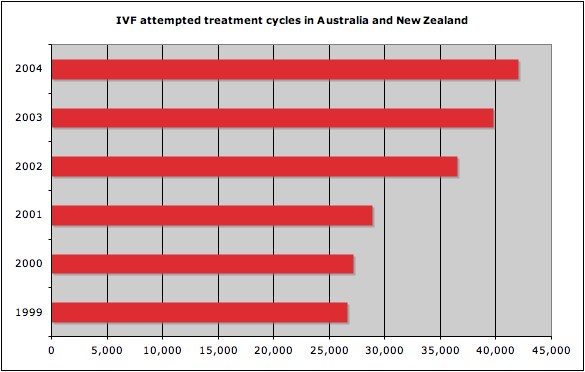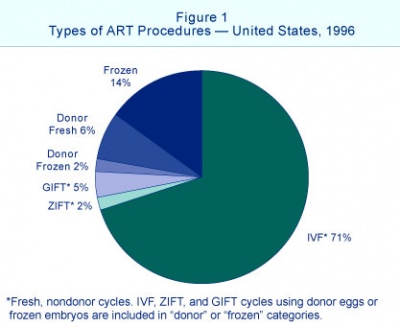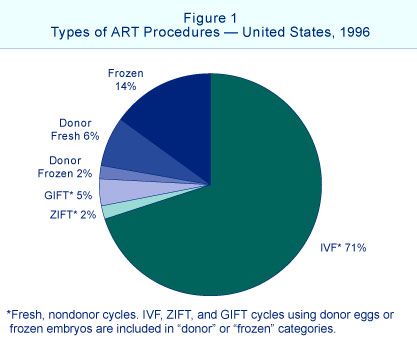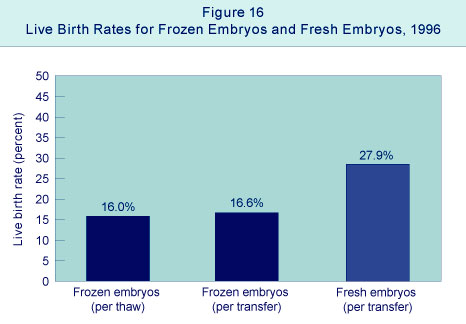In Vitro Fertilization: Difference between revisions
| Line 60: | Line 60: | ||
{| class="prettytable" | {| class="prettytable" | ||
| [[File:IVF cycles ANZ 1999-2004.jpg]] | | [[File:IVF cycles ANZ 1999-2004.jpg]] | ||
| '''2005''' - 51,017 treatment cycles reported to ANZARD in Australia and New Zealand in 2005. Of these cycles, 91.1% were from Australian fertility centres and 8.9% from New | | '''2005''' - 51,017 treatment cycles reported to ANZARD in Australia and New Zealand in 2005. Of these cycles, 91.1% were from Australian fertility centres and 8.9% from New Zealand's centres. There is an increase of 13.7% of ART treatment cycles from 2004. | ||
(AIHW National Perinatal Statistics Unit [http://www.preru.unsw.edu.au/PRERUWeb.nsf/page/art11 Assisted Reproduction Technology in Australia and New Zealand 2005]) | (AIHW National Perinatal Statistics Unit [http://www.preru.unsw.edu.au/PRERUWeb.nsf/page/art11 Assisted Reproduction Technology in Australia and New Zealand 2005]) | ||
Revision as of 14:49, 20 July 2010
Introduction
In vitro fertilization covers the aided fertilization process, in contrast with in vivo fertilization which is the normal uterine occuring fertilization process. From the first successful IVF carried out in the UK in 1978 by Edwards RG, et al.[1] this technique continues to grow worldwide with new medical technologies.
The Latin, In vitro = "in glass" meaning in essence a test tube as apposed to in vivo (in life or a living body). Note that even in vivo fertilization can also now be assisted through some fertility drug treatments. Both processes have the same biological outcome, fusion of male and female gametes to form a diploid zygote.
In Australia during 2005 1,596 IVF babies were born. In the same year in Australia and New Zealand 51,017 treatment cycles were reported, an increase of 13.7% of ART treatment cycles from 2004. In all countries using Assisted Reproductive Technologies (ART), pregnancy rates vary for the different methods of treatment and also between individual IVF or GIFT units. In Australia best clinical pregnancy rate (per 100 oocyte retrieval cycles) by most successful 25% of all clinics increased from 24.9% (1998) to 34.4% (2001) (NPSU data - ART 2002 report)
--Mark Hill 22:30, 21 April 2010 (EST) Paage under development transferred from original.
Some Recent Findings
- A randomized controlled study of human serum albumin and serum substitute supplement as protein supplements for IVF culture and the effect on live birth rates. Meintjes M, Chantilis SJ, Ward DC, Douglas JD, Rodriguez AJ, Guerami AR, Bookout DM, Barnett BD, Madden JD. Hum Reprod. 2009 Apr;24(4):782-9. Epub 2009 Jan 14. PMID: 19147504
18 Ways to Make a Baby
- Natural sex
- Artificial insemination - of mother with father's sperm
- Artificial insemination - of mother with donor sperm
- Artificial insemination - with egg and sperm donors, using surrogate mother
- In vitro fertilization (IVF) - using egg and sperm of parents
- IVF - with Intra-Cytoplasmic Sperm Injection (ICSI)
- IVF - with frozen embryos
- IVF - with Preimplantation Genetic Diagnosis (PGD)
- IVF - with egg donor
- IVF - with sperm donor
- IVF - with egg and sperm donor
- IVF - with surrogate using parents' egg and sperm
- IVF - with surrogate and egg donor
- IVF - with surrogate and sperm donor
- IVF - with surrogate using her egg, sperm from baby's father
- IVF - with surrogate using egg and sperm donors*
- Cytoplasmic transfer**
- Nuclear transfer and cloning
Embryo Culture Milestones
- 1949 8 cell mouse embryo -> blastocyst (in saline and egg yolk)
- 1956 8 cell mouse embryo -> blastocyst (first embryo culture medium)
- 1957 2 cell mouse embryo -> blastocyst
- 1958 8 cell mouse embryo -> blastocyst, then transferred to pregnant recipient
- 1960's development of culture requirements for mouse mebryos
- 1965 2 cell mouse embryo -> blastocyst, then transferred into pseudopregnant recipient
- 1968 zygotes from mouse -> blastocysts
- 1968,70 2 & 4 cell rabbit embryos -> blastocyst in serum supplemented medium
- 1970,71 1 & 2 cell rabbit embryos -> blastocyst in defined medium
- 1970,81 Culture of in vitro fertilized human embryo -> 16 cells -> blastula
- 1998 Cloning of adult sheep "dolly"
- 2004 Cloning of human blastocysts
Data modified from[2]
Oldest IVF Mother
There is still risk, ethical and genetic debate about very old women becoming pregnant by IVF.
- 2003 India - A 65-year old Indian woman was the oldest in the world to give birth by IVF. (More? ABC News)
- 2006 United Kingdom - A 62-year old woman has become the UK's oldest woman to give birth to a child. (More? IVF Net)
- 2008 Australia - A 54-year old woman has become Australia's oldest woman pregnant by IVF (most Australian IVF clinics do not treat women over 50)
Assisted Reproductive Technology (Australia and New Zealand)

|
2005 - 51,017 treatment cycles reported to ANZARD in Australia and New Zealand in 2005. Of these cycles, 91.1% were from Australian fertility centres and 8.9% from New Zealand's centres. There is an increase of 13.7% of ART treatment cycles from 2004.
(AIHW National Perinatal Statistics Unit Assisted Reproduction Technology in Australia and New Zealand 2005) |
Average age of women was 35.5 years (35.2 years in 2002). Women aged older than 40 years has increased from 14.3% in 2002 to 15.3% in 2005.
Since ANZARD was established in 2002 there has been a significant increase in the number of embryos transfer cycles where women received single-embryo transfers (SET). SET cycles accounted for 48.3% of embryos transfer cycles in 2005, compared to 28.4% in 2002. The increase of SET cycles resulted more singleton deliveries. The proportion of singleton deliveries was 85.9% in 2005, the highest proportion ever reported.
Babies born to women who had a single-embryo transfer had better outcomes compared to babies born to women who had a double-embryo transfer (DET). In 2005, there were 3,681 SET babies and 5,589 DET babies. In SET babies, 96.1% were singletons, compared to 61.6% singletons in DET babies. SET babies had a lower proportion of preterm babies (11.7%), compared to 30.6% in DET babies. Similarly, 8.0% of SET liveborn babies were low birthweight, compared to 25.0% in DET liveborn babies.
Perinatal mortality rate is a measure of perinatal outcomes. In 2005, for all babies born following ART treatment, the perinatal mortality rate was 14.7 deaths per 1,000 births, a 23.8% decrease from 19.3 deaths per 1,000 births in 2004. The perinatal mortality rate was the lowest among singletons born following SET (7.3 deaths per 1,000 births) in 2005.
(AIHW National Perinatal Statistics Unit Assisted Reproduction Technology in Australia and New Zealand 2005)
2004 - 41,904 IVF treatment cycles were started in Australia 92.6% (38,823) and New Zealand 7.4% (3,081). (More? NPSU Assisted Reproduction Technology Reports)
In Vitro Fertilization - ABC News Baby born from frozen embryo
"In what's thought to be a world first, a baby has been born in Melbourne using a woman's frozen egg and a donor's frozen sperm which created an embryo that was also frozen, then thawed and implanted into the mother"
"JOHN MCBAIN: Oh egg freezing is very difficult. Embryo freezing itself is very well established. We would probably have about 55 per cent of all the babies born from our program, and that's about 1,400 a year, come from frozen embryos. So, that's very well established technology. But even with these embryos, only 70 per cent of the embryos survive the freezing and thawing. With eggs, it's closer to 40 to 50 per cent, and then you have to have the number which don't fertilise following that, and then you have to have those which end up being frozen, possibly not surviving the embryo freezing stage too, and that's a reason we don't promote it."
Assisted Reproductive Technology (USA)
- Centre for Disease Control (USA) 1999 Survey of Assisted Reproductive Technology: Embryo Laboratory procedures and Practices (January 29, 1999) [../embryo/pdf/ARTsurvey.pdf PDF Version 473KB] The latest USA statistics including the survey document.
- 1996 Assisted Reproductive Technology Success Rates National Summary and Fertility Clinic Reports
- The 1996 report of pregnancy success rates is the second to be issued. The report includes a national report that uses information from 300 U.S. fertility clinics to provide an indepth national picture of ART; fertility clinic tables that provide ART success rates for each clinic that submitted and verified its1996 data; and an appendix containing a glossary of terms and lists of reporting and nonreporting clinics in the United States.
- See Pie Graph
- 1995 Assisted Reproductive Technology Success Rates National Summary and Fertility Clinic Report.
- This report gives consumers and potential assisted reproductive technology (ART) users an idea of a woman's average chances of having a pregnancy and a live birth by using ART. The report includes a national summary that uses the information from all reporting fertility clinics to provide an indepth national picture of ART; fertility clinic reports that provide ART success rates for 259 clinics in the United States; and an appendix containing a glossary of terms used in the national and clinic reports.
European Society of Human Reproduction and Embryology
Reports annually (in the journal Human Reproduction) on the European results of assisted reproductive techniques. Listed below are some statistical information gathered from reporting clinics for the current 2001 report. ESHRE Report 2001
Highlights from the 2001 Report
- From 23 countries, 579 clinics reported 289,690 cycles
- IVF 120,946, ICSI 114,378, frozen embryo transfer (FER) 47,195 and egg donation (ED) 7,171 (4% increase since the year 2000)
- European data on intra-uterine inseminations (IUIs) were reported from 15 countries. A total of 67 124 cycles [IUI husband'sperm (IUI-H) 52 949 and IUI donor sperm (IUI-D) 14 185] were included.
- In 12 countries where all clinics reported to the register, a total of 108 910 cycles were performed in a population of 131.4 million (829 cycles/million inhabitants).
- IVF- clinical pregnancy rate per aspiration and per transfer was 25.1 and 29.0%, respectively.
- ICSI- clinical pregnancy rate per aspiration and per transfer was 26.2 and 28.3% (similar to the results from 2000).
- IUI-H- clinical pregnancy rate was 12.8% in women less than 40 and 9.7% in women 40 years of age.
- After IVF and ICSI, the distribution of transfer of one, two, three and 4 embryos was 12.0, 51.7, 30.8 and 5.5%, respectively.
- Distribution of singleton, twin and triplet deliveries for IVF and ICSI combined was 74.5, 24.0 and 1.5%, respectively.
- Range of triplet deliveries after IVF and ICSI differed from 0.0 to 8.2% between countries.
- After IUI-H in women less than 40 years of age, 10.2% were twin and 1.1% were triplet gestations.
Human Fertilisation and Embryology Authority UK (HFEA)
The UK Human Fertilisation and Embryology Authority (HFEA) was established in August 1991 following the passing of the Human Fertilisation and Embryology Act 1990 (HFE Act).
The HFEA's principal tasks are to:
- License and monitor clinics that carry out in vitro fertilisation (IVF) and donor insemination
- License and monitor research centres undertaking human embryo research
- Regulate the storage of gametes and embryos
HFEA also provide a downloadable patient booklet: Your Guide to Infertility and website information on Patients' Guide to Donor Insemination (DI)
(More? Human Fertilisation and Embryology Authority, UK)
Sweden
Sweden had its first child born after in vitro fertilisation 20 years ago. A recent paper in BMJ looks at the change in multiple birthrates since a change in the early 1990s, to reduce the number of embryos transferred in the clinic from three to two.
"The rate of multiple births after in vitro fertilisation increased to a maximum of 29% in 1991 but fell to 18.5% by 2001, resulting in a 70% reduction of preterm births"
Temporal trends in multiple births after in vitro fertilisation in Sweden, 1982-2001: a register study Bengt Kallen, Orvar Finnstrom, Karl Gosta Nygren, Petra Otterblad Olausson
External Links
Note that the dynamic nature of the internet may mean that some of the above links may no longer function. If the link no longer works search the web with the above link name.
- Assisted reproductive technology in Australia and New Zealand 2002 Report - Highlights Has links to the full report online.
- (Australian) National Perinatal Statistics Unit
- (Australian) National Perinatal Statistics Unit Assisted Reproduction Technology Reports
- The Australian Infertility Support Group
- The Merck Manual | The Merck Manual- Infertility | The Merck Manual- Pregnancy | Search The Merck Manual "Infertility" | Search The Merck Manual "Pregnancy"
- Sydney Commercial IVF Sites Sydney IVF | Citywest IVF | IVF South | North Shore Fertility Pty Ltd
- Human Fertilisation and Embryology Authority (UK) | Human Fertilisation and Embryology Authority (UK) | Your Guide to Infertility | Patients' Guide to Donor Insemination (DI) | Patients FAQs | Patients Guide to IVF Clinics (UK)
References
- ↑ <pubmed>6775685</pubmed>
- ↑ Culture of preimplantation embryos: facts and artifacts. Bavister BD. Hum Reprod Update. 1995 Mar;1(2):91-148. Review. PMID: 15726768
Reviews
Articles
Search Pubmed
Search Pubmed Now: in vitro fertilization | assisted reproduction technology
Glossary Links
- Glossary: A | B | C | D | E | F | G | H | I | J | K | L | M | N | O | P | Q | R | S | T | U | V | W | X | Y | Z | Numbers | Symbols | Term Link
Cite this page: Hill, M.A. (2024, May 3) Embryology In Vitro Fertilization. Retrieved from https://embryology.med.unsw.edu.au/embryology/index.php/In_Vitro_Fertilization
- © Dr Mark Hill 2024, UNSW Embryology ISBN: 978 0 7334 2609 4 - UNSW CRICOS Provider Code No. 00098G


